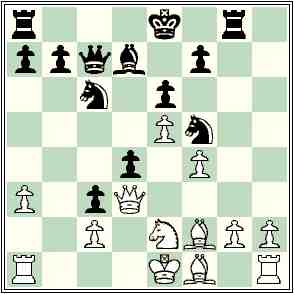 The fifth issue of The New Winawer Report has been posted: see the tnwr page. This issue continues with the much-maligned, but much-better-than-its-reputation, 13. Be3.
The fifth issue of The New Winawer Report has been posted: see the tnwr page. This issue continues with the much-maligned, but much-better-than-its-reputation, 13. Be3.
Black has a few viable options, but one of the main lines reaches the diagram at right, where White’s Be3-f2 has had the effect of inducing the committal … Nf5 and … d4. White may now proceed with either 15. h3 or 15. Rg1, planning in each case to follow up with g4. Although Black has an effective counter, this is overestimated by theory: Black has a narrow path to equality, but no more than that. Or so it seems to me: see the issue for full details.
Possibly the most important game featuring 13. Be3 was Spassky-Korchnoi, Candidates Final (2), 1977. In response Korchnoi sprung the surprise 13. … d4!?, a novelty, and won in great style. Much ink has been spilled on that, but I’ve never seen a persuasive answer to another question: what did Spassky have in mind, assuming Korchnoi continued with the usual 13. … Nf5 or 13. … 0-0-0, since 13. Be3 had had a dismal reputation for fifteen years or more by that point? I’ve seen the suggestions 13. … Nf5 14. Bf2 d4 (reaching the diagram above) 15. g4?! (Hartston in BCM, shortly after the match) or here 15. Ng3 0-0-0 16. Ne4 (a losing blunder!) in Archives, late ’80’s, but don’t find either very believable. Did Spassky ever say?
Anyway, the nest issue is tentatively planned to switch to the line 13. h3!?, with the plan of an immediate g4 (cutting out the Be3-f2 middleman). This was introduced by the late Robert Byrne in a famous game against Uhlmann in Monte Carlo 1968, and is a much more respectable try for White, especially as Uhlmann’s solution no longer seems to hold up theoretically.
